The Macron Green Pass? Inapplicable in Italy, that’s why. Gimbe Report

Facts, numbers, scenarios and comments of the Gimbe foundation chaired by Nino Cartabellotta on the vaccination campaign and more. As for the Green Pass launched by France …
The Macron Green Pass? Inapplicable in Italy. Word of the Gimbe foundation that analyzes the progress of the pandemic and the vaccination campaign in Italy.
"If virtuous behavior remains fundamental to limit the circulation of the virus, the use of the green pass on the French model for access to bars, restaurants and other activities, although desirable, is not very applicable in the short term due to various obstacles that should be faced and removed ”, comments the doctor Nino Cartabellotta, president of the Gimbe foundation.
First of all – underlines Cartabellotta – the unavailability of vaccines for all those who would like to receive them and the non-free swabs in all Regions generates a risk of discrimination; secondly, tools and resources are needed for tight and systematic checks ”.
Finally, according to the president of the Gimbe foundation – “there is no law on the obligation to vaccinate for those who carry out tasks in contact with the public. Last, but not least, it is essential to put the theme of schools back at the center of the political agenda: in the absence of the lack of structural and organizational adjustments, in fact, for the next school year there is a real risk of having to resort again to distance learning, also considering that about 75% of the population 12-19 and over 216 thousand people employed in schools (14.8%) have not yet received even a dose of vaccine ".
Here is the updated report edited by the Gimbe foundation on the progress of the pandemic, the delta variant and the vaccination campaign in Italy
+++
The independent monitoring of the Gimbe Foundation detects in the week 7-13 July 2021, compared to the previous one, an increase of 61.4% of new cases (8,989 vs 5,571) (figure 1); On the other hand, deaths are confirmed (104 vs 162) (figure 2), currently positive cases (40,649 vs 42,579), people in home isolation (39,364 vs 41,121), hospitalizations with symptoms (1,128 vs 1,271) and therapies intensive (157 vs 187) (figure 3). In detail, compared to the previous week, the following changes were recorded:
- Deaths: 104 (-35.8%)
- Intensive care: -30 (-16%)
- Hospitalized with symptoms: -143 (-11.3%)
- Home isolation: -1,757 (-4.3%)
- New cases: 8,989 (61.4%)
- Currently positive cases: -1,930 (-4.5%)
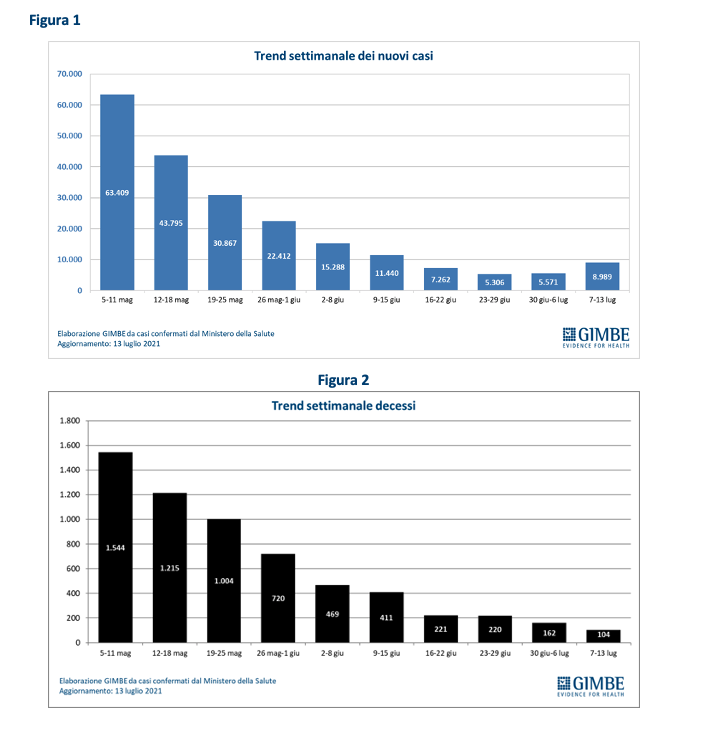
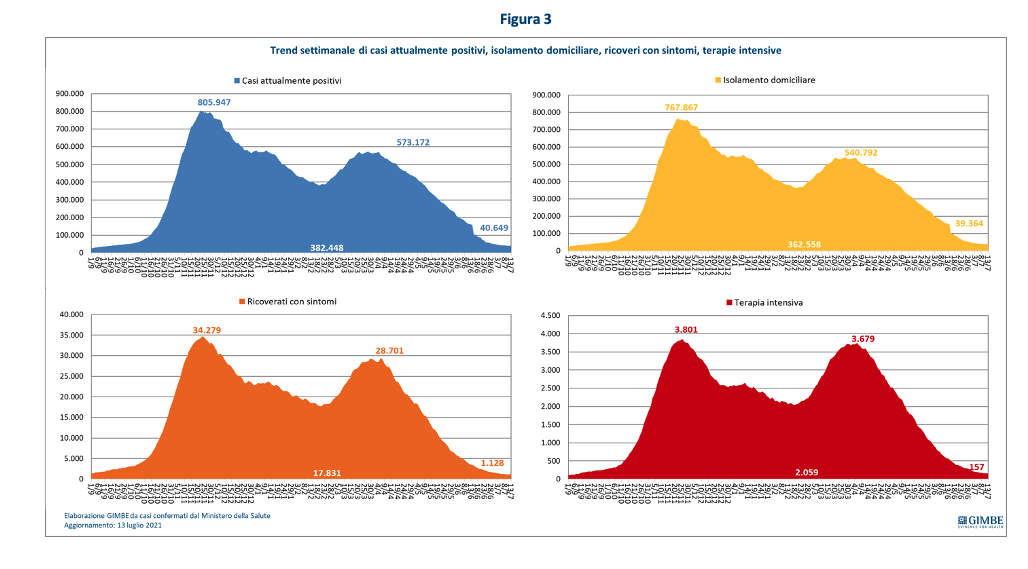
"On the front of the new cases – declares Nino Cartabellotta, President of the Gimbe Foundation – there is a net weekly increase, however underestimated by a continuously decreasing testing activity, which makes it impossible to trace the contacts adequately". Since the beginning of May, the number of people tested weekly has in fact progressively decreased by 56.3%, from 662,549 to 289,869 (figure 4). In the week 7-13 July in all Regions, with the exception of Basilicata and Valle D'Aosta, there was a percentage increase in new cases compared to the previous week due to the progressive spread of the delta variant (table). Deaths, on the other hand, continue to decline, settling at 104 in the last week with an average of 15 per day compared to 24 in the previous week.
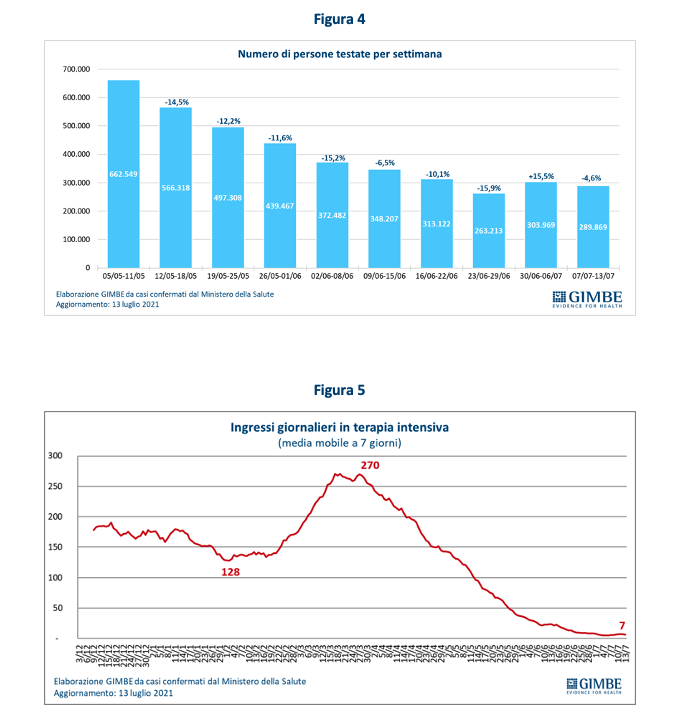
"The trend of hospitalized patients – says Renata Gili, Head of Research on Health Services of the Gimbe Foundation – continues its descent both in the medical area and in intensive care, where the occupation of beds by Covid patients stands at 2% ". All Regions record values of less than 10% for the medical area and 5% for intensive care in which there are 7 Regions that do not count Covid patients. "Daily admissions to intensive care – explains Marco Mosti, Operations Director of the Gimbe Foundation – have been decreasing for over 3 months, in the last week they recorded a slight increase with the 7-day moving average which is 7 admissions / day compared to 5 of the previous week "(figure 5).
Vaccines: supplies.
As of July 14 (update 6.12) 63,659,024 doses have been delivered (figure 6). At the moment it is impossible to make forecasts for the 3rd quarter given that the last update of the supply plan dates back to 23 April and, in the absence of an official final balance, it is not known whether the 15.2 million doses not delivered in the 2nd Th quarter will be recovered or not in the coming months. In addition, estimates of more than 94 million doses for the third trimester are unrealistic as they include 6.64 million doses of the CureVac vaccine that failed clinical trials and 42 million doses of adenoviral vector vaccines for which the suspension of deliveries due to lack of use by the Regions was raised. In other words, in the third quarter we could only have 45.5 million doses of mRNA vaccines (Figure 7).
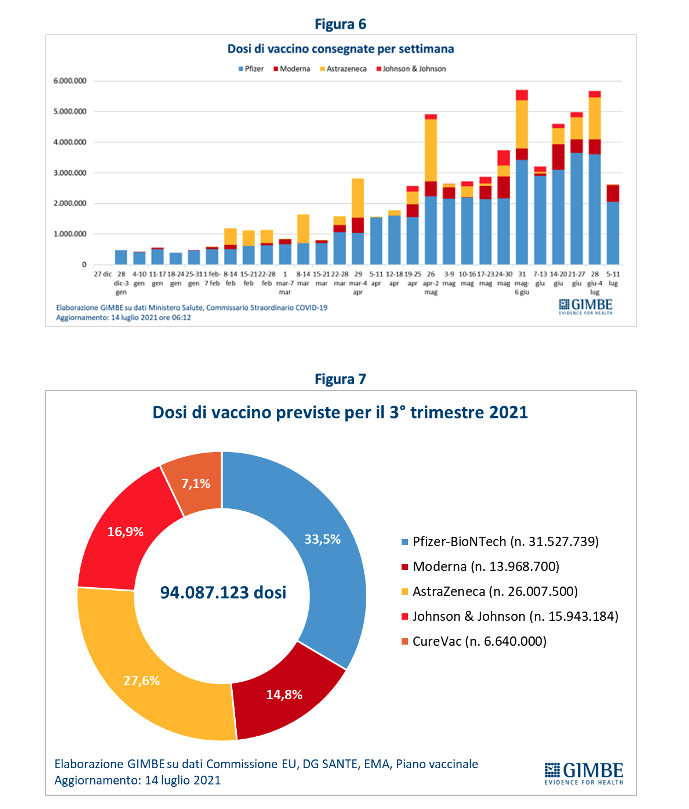
Vaccines: administrations.
As of July 14 (update 6.12), 60.8% of the population (n. 36,042,675) received at least one dose of vaccine (+719,235 compared to the previous week) and 41.9% (n. 24,801,699 ) completed the vaccination cycle (+3,208,392 compared to the previous week) (figure 8). The number of administrations remained stable in the last week (3,758,700) (figure 9), with a 7-day moving average of 543,873 inoculations / day (figure 10). A number of administrations that, despite over 4.8 million doses "in the fridge", remains stable both due to the growing distrust of the over 60s towards adenoviral vector vaccines (2.7 million doses available), and the need for set aside more than 2.16 million doses of mRNA vaccines for boosters, given the uncertainties on supplies that require the Regions to continue to stop and go on their agendas. "In this scenario – explains Mosti – the percentage of first doses on the total doses administered has been progressively reducing from 4 consecutive weeks: from 2,955,191 first doses of the week 7-13 June (74% of the total) it has passed to 809,518 of the week 5-11 July (22% of the total), with a decrease of 73% (figure 11).
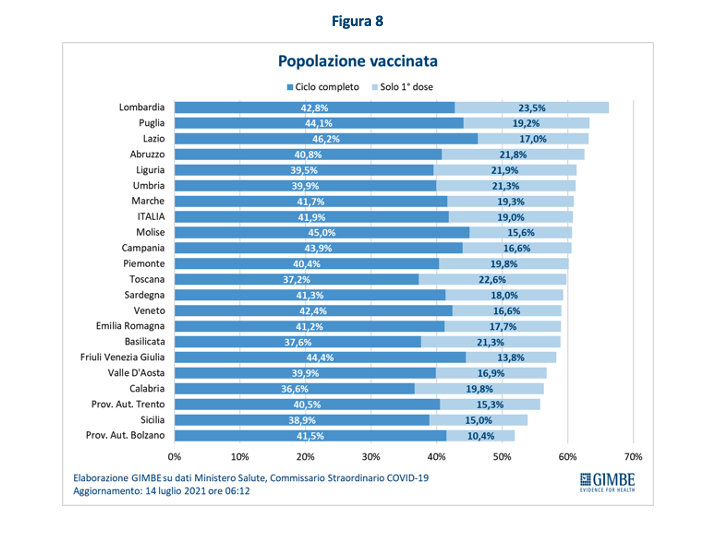
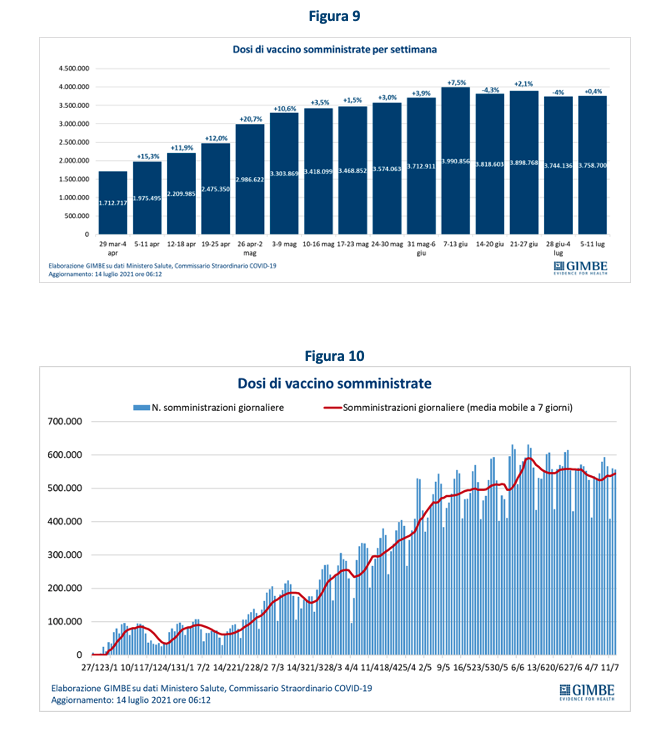
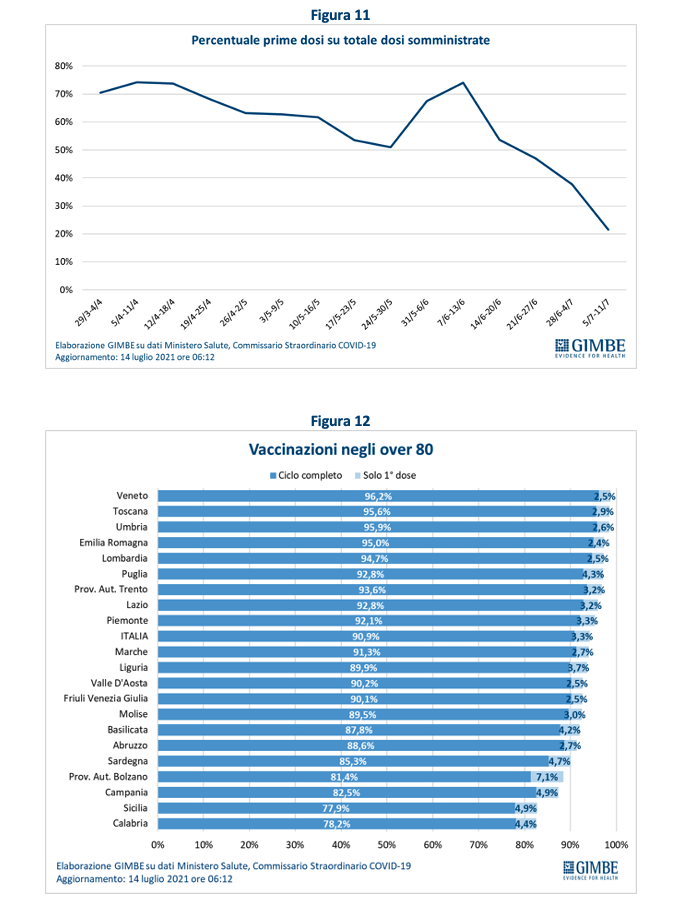
Vaccines: coverage of over 60s.
87.6% received at least one dose of vaccine, with a negligible weekly increase at national level (+ 0.4%) and clear regional differences: while Puglia, Umbria and Lazio have exceeded 90%, Sicily is at a standstill at 78.1%. In detail:
- Over 80: of the over 4.4 million, 4,073,553 (90.9%) completed the vaccination course and 149,191 (3.3%) received only the first dose (Figure 12).
- Age range 70-79: of the over 5.9 million, 4,468,306 (74.9%) completed the vaccination course and 805,770 (13.5%) received the first dose only (Figure 13).
- Age range 60-69: of the over 7.3 million, 4,571,634 (61.4%) completed the vaccination course and 1,593,861 (21.4%) received the first dose only (Figure 14).
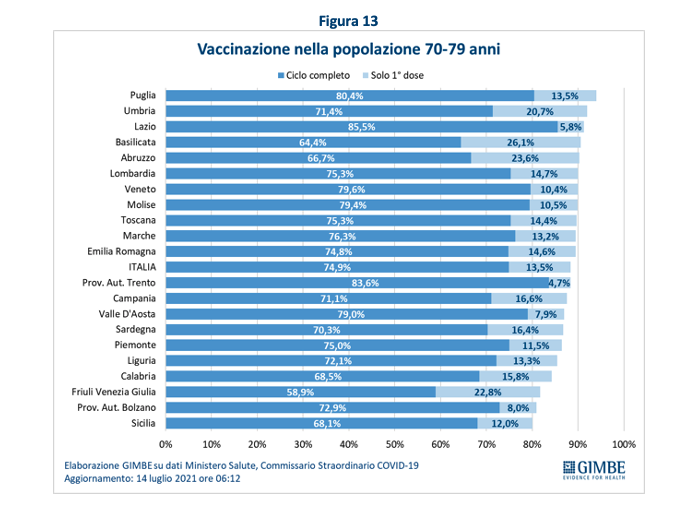
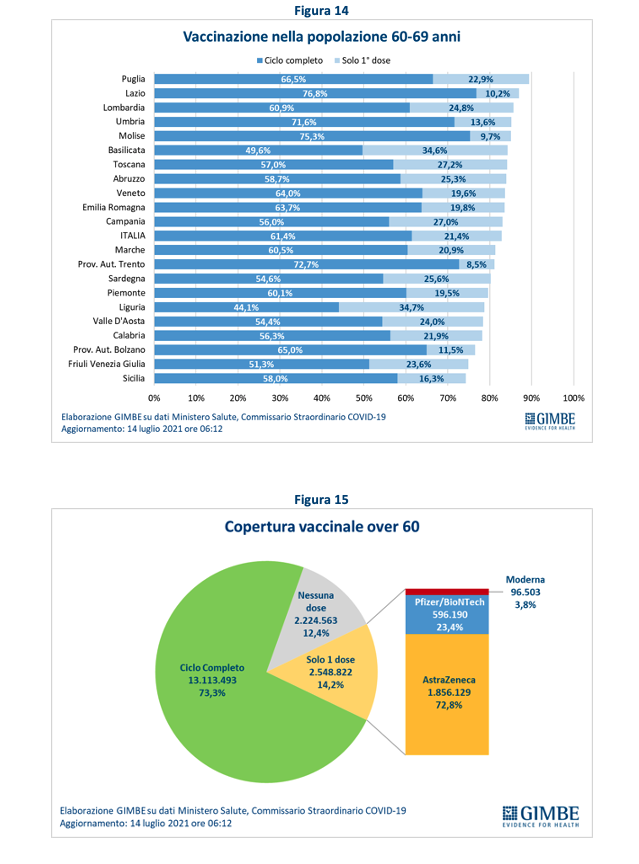
Delta variant.
Taking into account the progressive increase in cases and the spread of this variant which is destined to become prevalent, in our country the Achilles heel continues to be represented by over 4.77 million over 60s at risk of serious illness not covered by the double vaccine dose (figure 15): of these, 2.22 million (12.4%) have not yet received even a dose of vaccine with significant regional differences (from 21.8% in Sicily to 7.2% in Puglia) (figure 16), while 2.55 million (14.2%) must complete the cycle after the first dose (1,856,129 with AstraZeneca, 596,190 with Pfizer-BioNTech, 96,503 with Moderna). "The leap forward compared to the 5.75 million over 60s not adequately protected last week – points out Gili – is almost exclusively linked to the completion of vaccination cycles: in other words, the number of over 60s who receive the first dose does not grow , a sign of persistent vaccination hesitation in this age group ». Moreover, the trend of administration of the first doses by age group confirms the flattening of the curves of the over 80s and the 70-79 and 60-69 groups and a decline for all the other age groups (Figure 17), with considerable differences in coverage between the various personal data classes (figure 18).
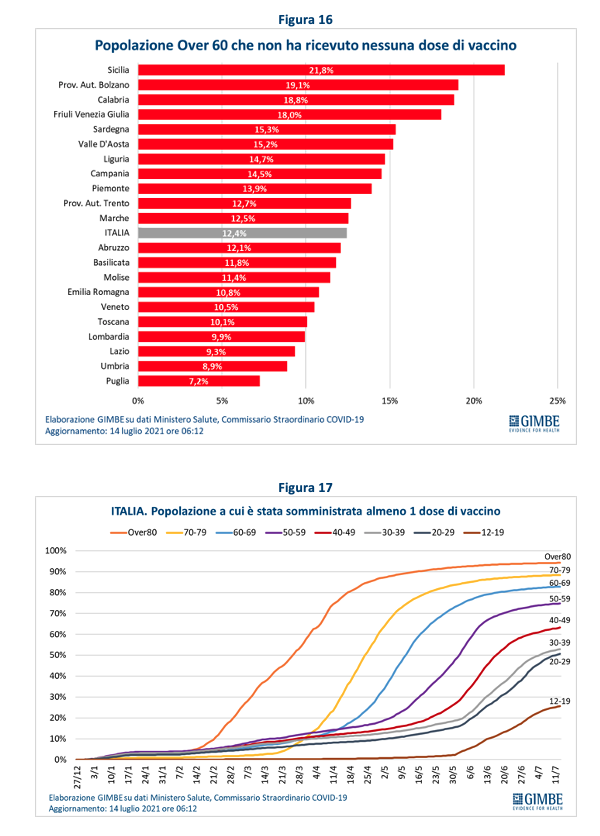
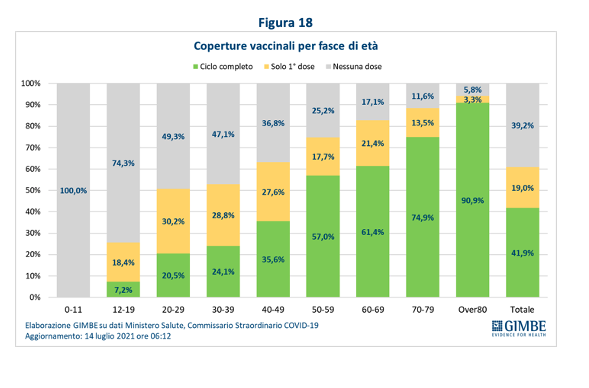
Future scenarios.
The management of the pandemic cannot be separated from a review of the dynamics of the circulation of SARS-CoV-2 and the impact of Covid-19 on hospitals that takes into account the spread of the delta variant and the criticalities of supply and administration of vaccines. In summary:
- Circulation of SARS-CoV-2: the progressive spread of the delta variant will determine, as has already happened in other European countries, an increase in the number of infections, the extent of which could be underestimated by the insufficient testing & tracing activity that characterizes our country .
- Impact of Covid-19: the increase in infections will determine an increase in hospitalizations and deaths, evident respectively not earlier than 2 and 4 weeks, the extent of which will be inversely proportional to the complete vaccination coverage of the population, in particular those over 60 and frail. In other words, even with high viral circulation, the impact of infections on health services will be less than in previous waves.
- Vaccine availability: with the gradual "sunset" of adenoviral vector vaccines and the CureVac flop, the vaccination campaign will only be able to count on mRNA vaccines which, according to the latest estimates, should reach 45.5 million doses in the third quarter.
- Vaccine administration: the collapse in the number of first doses follows both the need to complete vaccination cycles, and the reduction in deliveries and the exit from the scene of viral vector vaccines, which in fact imposed a slowdown on bookings, and on the vaccination hesitation of the over 50s, especially in the 50-59 and 60-69 bands where the number of first doses administered weekly is decreasing.
«As already foreseen three weeks ago – concludes Cartabellotta – the wait-and-see strategy to deal with the circulation of the delta variant did not work and now it is necessary to stem the consequences of the increase in infections by accelerating the complete vaccination coverage of over 60 and frail. If virtuous behavior remains fundamental to limit the circulation of the virus, the use of the green pass on the French model for access to bars, restaurants and other activities, although desirable, is not very applicable in the short term due to various obstacles that should be faced and removed. First of all, the unavailability of vaccines for all those who would like to receive them and the non-free swabs in all Regions generates a risk of discrimination; secondly, tools and resources are needed for tight and systematic checks; finally, there is no law on the vaccination obligation for those who perform tasks in contact with the public. Last, but not least, it is essential to put the theme of schools back at the center of the political agenda: in the absence of the lack of structural and organizational adjustments, in fact, for the next school year there is a real risk of having to resort again to distance learning, also considering that about 75% of the population 12-19 and over 216 thousand people employed in schools (14.8%) have not yet received even a dose of vaccine ».
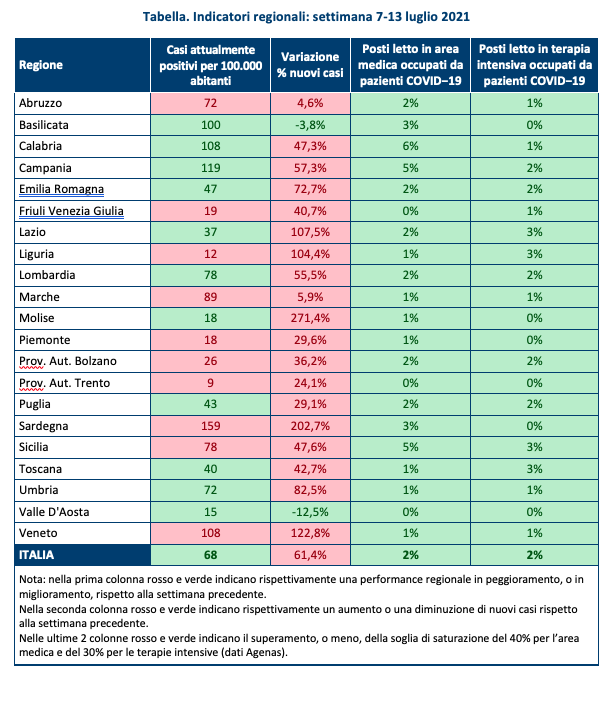
This is a machine translation from Italian language of a post published on Start Magazine at the URL https://www.startmag.it/sanita/il-green-pass-alla-macron-inapplicabile-in-italia-ecco-perche/ on Thu, 15 Jul 2021 07:51:28 +0000.
